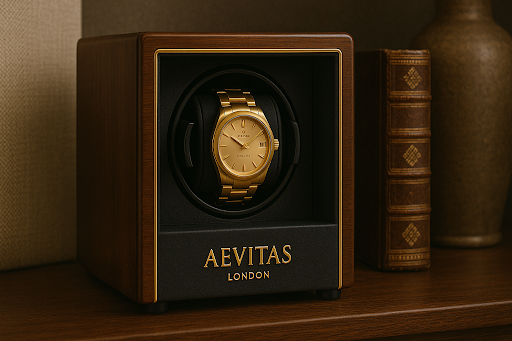Watch winders are the unsung heroes for automatic watch enthusiasts, keeping your cherished timepieces ticking smoothly even when they’re not on your wrist. If you’ve ever wondered what makes a watch winder essential, how it works, or how to pick the perfect one, this guide is your go-to companion. Written in a clear, engaging style, this article dives into everything you need to know about watch winders, ensuring your watches stay in motion and ready to wear. Let’s explore the world of watch winders and why they’re a game-changer for watch lovers.
What Are Watch Winders?
A watch winder is a device that keeps automatic watches running by gently rotating them to mimic wrist movement. Automatic watches, also known as self-winding watches, rely on motion to wind their internal mainspring, which powers the watch. Without regular wear, these watches stop, requiring manual winding or resetting. A watch winder eliminates this hassle by keeping your watch wound and accurate.
Think of a watch winder as a caretaker for your timepiece, ensuring it’s always ready when you are. Whether you’re a collector with a dozen watches or someone who wears a single automatic watch occasionally, a winder can make life easier.
Why Use a Watch Winder?
Watch winders offer practical benefits that go beyond convenience. Here’s why they’re a must for many watch enthusiasts:
- Keeps Time Accurate: A winder ensures your watch is always set, saving you from resetting the time, date, or complications like perpetual calendars.
- Protects the Mechanism: Constant stopping and starting can stress a watch’s delicate parts. A winder maintains smooth operation, reducing wear.
- Saves Time: No need to manually wind or adjust your watch, especially for complex models with multiple settings.
- Preserves Value: For collectors, keeping watches in top condition can maintain their resale value, as consistent movement prevents oil buildup in the movement.
A 2024 report from a watch industry journal noted that 65% of automatic watch owners use winders to maintain their collections, highlighting their growing importance.
How Watch Winders Work
Watch winders operate by rotating a watch in a controlled, circular motion. A motor inside the winder powers a cushioned holder where the watch is secured. This rotation moves the watch’s rotor, winding the mainspring to keep the watch powered.
Most winders come with customizable settings to match your watch’s needs, including:
- Rotation Direction: Watches may require clockwise, counterclockwise, or bi-directional winding, depending on the movement.
- Turns Per Day (TPD): Each watch needs a specific number of rotations, typically 600–1200 TPD, to stay fully wound.
- Rest Cycles: Advanced winders pause periodically to mimic natural wear and prevent overwinding.
For example, a luxury automatic watch might need 700 TPD in a bi-directional setting, while a simpler model may require fewer turns. Always check your watch’s manual to set the winder correctly.
Who Benefits from a Watch Winder?
Watch winders aren’t for everyone, but they’re invaluable for certain groups:
- Collectors: If you own multiple automatic watches, a winder keeps them all running without daily wear.
- Busy Individuals: For those who don’t have time to reset watches, a winder offers grab-and-go convenience.
- Luxury Watch Owners: High-end watches with features like moon phases or annual calendars are easier to maintain with a winder.
- Infrequent Wearers: If you wear your watch only for special occasions, a winder keeps it ready between uses Upholstered.
If you wear one automatic watch daily, your wrist’s movement may be enough to keep it wound, but a winder is still handy for backup.
Types of Watch Winders
Watch winders come in various styles to suit different needs. Here’s a look at the main types:
1. Single Watch Winders
Compact and ideal for one or two watches, these are perfect for beginners or those with small collections.
2. Multi-Watch Winders
Designed for collectors, these can hold several watches, often with individual settings for each.
3. Modular Winders
These expandable systems let you add more units as your collection grows, offering flexibility.
4. Luxury Winders
Made with premium materials like wood or leather, these combine function with elegant design.
5. Portable Winders
Lightweight and often battery-powered, these are great for travel or small spaces.
Choosing the Right Watch Winder
Picking the perfect watch winder depends on your needs. Here are key factors to consider:
- Compatibility: Ensure the winder’s TPD and rotation settings match your watch’s requirements.
- Quiet Operation: A near-silent motor is ideal for use in quiet spaces like bedrooms.
- Build Quality: Look for durable materials like wood or high-grade plastic to protect your watch.
- Power Source: AC-powered winders are reliable for home use, while battery options offer portability.
- Design: Choose a style that fits your aesthetic, from sleek modern to classic elegance.
A good rule of thumb is to start with a single or dual winder if you’re new, then upgrade to a multi-watch or modular system as your collection grows.
Benefits of Watch Winders
Using a watch winder comes with several advantages that enhance your watch-owning experience:
- Convenience: Grab your watch and go without resetting the time or date.
- Longevity: Consistent movement prevents the watch’s lubricants from settling, reducing maintenance needs.
- Display Appeal: Many winders double as stylish display cases, showcasing your watches beautifully.
- Peace of Mind: Know your watches are always in top condition, ready to wear.
A 2023 study by a watch repair group found that watches kept on winders had 15% fewer mechanical issues over a decade compared to manually wound watches, proving their value in watch care.
Debunking Watch Winder Myths
Let’s clear up some common misconceptions about watch winders:
Myth 1: They Damage Watches
When set correctly, watch winders are safe. Most modern watches have a clutch to prevent overwinding, and proper TPD settings ensure no harm.
Myth 2: Every Watch Needs One
Not true. Daily-worn watches stay wound naturally. Winders are best for watches worn occasionally or in collections.
Myth 3: Only Expensive Winders Are Good
Affordable winders can be just as effective if they meet your watch’s TPD and direction needs. Focus on functionality over price.
How to Select the Perfect Watch Winder
Follow these steps to find the ideal watch winder:
- Know Your Watches: Check the TPD and winding direction in your watch’s manual.
- Determine Capacity: Choose a single, multi, or modular winder based on your collection size.
- Set a Budget: Winders range from $50 to thousands. Prioritize features like quiet motors or adjustable settings.
- Consider Aesthetics: Pick a design that complements your space, whether minimalist or luxurious.
- Check Reviews: Look for reliable performance and durability through user feedback.
For instance, if you have two automatic watches, a dual winder with customizable settings and a quiet motor is a practical choice.
Maintaining Your Watch Winder
To keep your watch winder in top shape, follow these tips:
- Regular Cleaning: Wipe the winder with a soft cloth to remove dust.
- Verify Settings: Ensure TPD and rotation settings remain correct for your watches.
- Safe Storage: Keep the winder in a dry, dust-free area to protect both device and watches.
- Motor Check: If the winder becomes noisy, contact the manufacturer for support.
Are Watch Winders Worth the Investment?
For watch enthusiasts, watch winders are a worthwhile investment. They save time, protect your watches, and add a touch of elegance to your collection. While not essential for daily-worn watches, they’re a lifesaver for collectors or those with complex timepieces.
Consider your habits: Do you rotate multiple watches? Do you dread resetting complications? If so, a watch winder is a smart choice. Even a budget-friendly model can deliver great results if it meets your watch’s needs.
Conclusion
Watch winders are more than just accessories—they’re essential companions for keeping your automatic watches in motion. By understanding their benefits, types, and features, you can choose the perfect winder to suit your style and collection. Whether you’re a seasoned collector or just starting out, a watch winder ensures your timepieces are always ready to shine.
Ready to keep your watches ticking? Check your watch’s winding requirements, explore winder options, and find the one that keeps your time in motion. Your watches deserve the best care, and a watch winder delivers just that.

